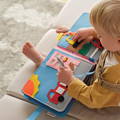How to Recognize a Montessori Book: A Guide for Parents
Choosing the right books for your child doesn’t have tо be overwhelming, especially іf you’re following Montessori principles. In a world full оf fairy tales, noisy books, and cartoonish characters, іt can be hard tо know which stories actually support your child’s growth.

So what makes a book Montessori-friendly, and how can you spot one?
Luckily for you, that’s exactly what we’re here to find out.
What Makes a Book Montessori-Friendly?
Montessori-aligned books focus on reality over fantasy, especially during the early years. These books support a child’s natural development by reflecting the world they live in.

Montessori-friendly books have some features that can help you distinguish them from other books, such as:
- Realistic content: Stories are grounded in everyday life and talk about things like meals, nature walks, routines, or caregiving, not fantasy or make-believe.
- Simple, clear language: The text should be age-appropriate for your little one and meaningful, not overly silly or filled with nonsense words.
- Concrete concepts: Montessori books talk about ideas children can see, touch, and relate to, like planting a seed or washing hands.
- Realistic visuals: Whether it’s photography or drawings, images should clearly reflect real people, places, and objects.
- Focus on independence: Books often highlight tasks children can try on their own, like dressing, cooking, or sweeping.
- Self-discovery and observation: The tone is gentle and respectful, encouraging curiosity without loud humor or over-the-top action.
Montessori books don’t entertain for the sake of entertainment. They help children connect language with meaning and find their place in the real world.
Real-Life Focus Over Fantasy
One of the most distinctive things about Montessori books is their commitment to realism. Maria Montessori believed that young children form their understanding of the world in the early years, and fantasy or talking animals can confuse those early perceptions.

Instead of dragons and wizards, Montessori books offer stories about:
- Visiting the doctor
- Helping set the table
- Taking care of a pet
- Going for a walk in the rain
This doesn’t mean that imagination is discouraged. It simply means the foundation is built on real-life experiences. When children know what’s real, their creativity grows from a place of understanding, not confusion.
Concrete Concepts and Realistic Illustrations
Young children think in concrete terms. That’s why books should show them things they can actually recognize and experience. The visuals in Montessori books are especially important because they serve as the link between language and meaning.

Montessori-friendly books use:
- Clear photographs or lifelike illustrations
- Accurate depictions of people, animals, and objects
- Consistent styles that don’t distract from the story
Cartoon animals in hats may be cute, but for a toddler, they can send mixed signals. Children are constantly observing and categorizing, so the more accurate the visuals, the better their understanding of the world.
Limited and Purposeful Text
When it comes to Montessori books, less is often more. Children, especially babies and toddlers, don’t need long, drawn-out stories. What they benefit from most is simple, clear language that connects directly to what they’re seeing on the page.

For younger children, look for books with just a few words per page. These words should be descriptive and meaningful, not overly silly оr repetitive just for the sake оf rhyme. A phrase like “She brushes her teeth” says more tо a toddler than a page full оf unrelated rhymes.
As children grow, the language can become a bit more complex, but it should still feel natural and grounded. For preschoolers, a slightly richer vocabulary introduces new words in a way that’s easy to understand.
The text should match your child’s developmental stage and attention span. A thoughtfully written book helps build focus, vocabulary, and comprehension, one sentence at a time.
Durable, Child-Handled Formats
In Montessori homes, books are meant tо be handled, explored, and revisited often. Sо, it’s not just about what you find inside the books, but also about what the physical format оf the book іs like.

A Montessori book wouldn’t fall apart іf you looked at іt the wrong way.
For babies and toddlers, board books are the best option. They’re sturdy, easy to grip, and can withstand a fair bit of chewing or tossing. As children grow, softcover books with thicker pages can be a great next step.
These formats support independence by allowing kids to turn pages on their own without constant help.
The idea is simple: When books are made for children’s hands, they can explore stories at their own pace while building confidence and ownership along the way.
Support for Independence and Self-Directed Learning
Montessori books are more than stories, they're quiet invitations to act. The best ones reflect everyday activities and routines, encouraging children to try things for themselves.
Instead of just watching a character go on an adventure, Montessori-aligned books show children brushing their teeth, getting dressed, planting a seed, or baking with a parent. These relatable moments give kids ideas they can carry into real life.
When a child sees someone their age sweeping the floor or setting the table in a book, it sparks something inside them: “I can do that, too.”
This kind of story doesn’t just entertain; it connects. It reinforces the idea that learning happens through doing and that the child is capable, curious, and in charge of their own growth.
Representing Diversity in Montessori Books
Montessori education values respect for oneself, for others, and for the world. That’s why Montessori-friendly books need to reflect the rich variety of people, families, and cultures children see in everyday life.

Books should show real representation: families of different races, cultures, abilities, and backgrounds. The goal isn’t just inclusion, it’s normalization. When children see a range of people living real, relatable lives in books, they grow up to be more open-minded and empathetic.
It’s also key to avoid tokenism. Look for books that celebrate diversity naturally, not as a special topic but as part of everyday routines like mealtime, school, or playing outside.
Montessori books don’t push a message.
They simply offer windows and mirrors. Windows into someone else’s life and mirrors that reflect a child’s own.
Montessori Book Recommendations by Age
Montessori books look a little different depending on your child’s age and stage of development. Here’s how to choose the right kind of book, along with some great options for each age group.
If you’re looking for a good Montessori book for the littlest ones, you should look for:
- High-contrast images
- Real photos of babies, animals, or common objects
- Minimal or no text
Here are a couple of great examples:
For the adorable toddlers in your life, you should look for:
- Books about daily routines (brushing teeth, helping in the kitchen)
- Realistic photos or illustrations of children
- Simple but descriptive language
Check out these:
And finally, if your little one is about to start school soon, you should look for:
- Real-world photos and nonfiction topics
- Richer vocabulary, still age-appropriate
- Stories that spark curiosity about the wider world
These are some nice editions you can check out:
Conclusion:
Choosing Montessori books isn’t about following strict rules, it’s about finding stories that reflect real life, encourage independence, and spark meaningful curiosity.
When books are grounded іn the child’s world and are developmentally appropriate, they become more than entertainment. They become tools for learning, exploring, and growing.
Free Delivery
Over $80
Easy Returns
No questions asked
Unbeatable Warranty
1-year ++ warranty
- Secure CheckoutWorld’s most secure payment method




